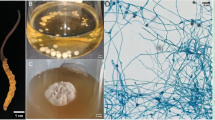Abstract
Participation of steroid hormones in the growth of several fungal species has been widely reported. The aim of the present study was to detect the presence and expression of the corticosteroid binding protein (CBP) gene in different pathogenic fungal isolates from human clinical specimens. Genomic DNA and total RNA were obtained from six different pathogenic fungal species and submitted to Southern blot and Reverse Transcription-Polymerase Chain Reaction respectively. The results indicated that all the fungi studied presented and expressed CBP gene. The sequence of a PCR product of CBP gene fragment corresponding to the carboxyl terminal region in Trichophyton mentagrophytes, which presented the highest CBP expression, showed an identity of 98% as compared to the previously reported gene sequence from Candida albicans. The overall results indicate that CBP is a highly conserved gene in fungi and suggest that steroid hormones should play an important physiological role in these eukaryotic organisms.
Similar content being viewed by others
References
Apisarnthanarax Y, Self SJ, Ramer G, Montes LF. Oral contraceptives and candidiasis. Cutis 1974; 14: 77‐82.
Hurley R. Inveterate vaginal trush. Practitioner 1975; 215: 753‐756.
Odds FC. Candida and Candidosis. Leicester: Leicester University Press, 1979.
Powell BL, Drutz DJ, Huppert M, Sun SH. Relationship of progesterone-and estradiol-binding proteins in Coccidioides immitis to coccidioidal dissemination in pregnancy. Infect Immun 1983; 40: 478‐485.
Restrepo A, Salazar ME, Cano LE, Stover EP, Feldman D, Stevens DA. Estrogens inhibit mycelium to yeast transformation in the fungus Paracoccidioides brasiliensis: implication for resistance of females to paracoccidioidomycosis. Infect Immun 1984; 46: 346‐353.
Restrepo A, Salazar ME, Cano LE, Stover EP, Feldman D, Stevens DA, Kinsman OS, Pitblado K, Coulson CJ. Effect of mammalian steroid hormones and luteinizing hormone on the germination of Candida albicans and implications for vaginal candidosis. Mycoses 1988; 31: 617‐626.
Skowronski R, Feldman D. Characterization of an estrogenbinding protein in the yeast Candida albicans. Endocrinology 1989; 124: 1965‐1972.
Schar G, Stover EP, Clemons KV, Feldman D, Stevens DA. Progesterone binding and inhibition of growth in Trichophyton mentegrophytes. Infect Immun 1986; 52: 763‐767.
Hernández-Hernández F, De Bievre C, Camacho-Arroyo I, Cerbón M, Dupont B, López-Martínez R. Sex hormone effects on Phialophora verrucosa in vitro and characterization of progesterone receptors. J Med Vet Mycol 1995; 33: 235‐239.
Loose DS, Schurman DJ, Feldman D. A corticosteroid binding protein and endogenous ligand in C. albicans indicating a possible steroid-receptor system. Nature 1981; 293: 477‐479.
Loose DS, Feldman D. Characterization of a unique corticosterone-binding protein in Candida albicans. J Biol Chem 1982; 257: 4925‐4930.
Loose DS, Stevens DA, Schurman DJ, Feldman D. Distribution of a corticosteroid-binding protein in Candida and other fungal genera. J Gen Microbiol 1983; 129: 2379‐2385.
Malloy PJ, Zhao Xi, Madani ND, Feldman D. Cloning and expression of the gene from Candida albicans that encodes a high-affinity corticosteroid-binding protein. Proc Natl Acad Sci USA 1993; 90: 1902‐1906.
Hoffman CH, Winston F. A ten-minute DNA preparation from yeast efficiently releases autonomous plasmids for transformation of Eschenchia coli. Gene 1987; 57: 267‐272.
Feinberg A, Vogelstein B. A technique for radiolabelling DNA restriction endonuclease fragment to high specific activity. Anal Biochem 1983; 137: 6‐13.
Chomczynski P, Sacchi N. Single-step method of RNA isolation by acid guanidin thiocyanate-phenol-chloroform extractions. Anal Biochem 1987; 162: 156‐159.
Sanger F, Nicklen S, Coulson AR. DNA sequencing with chain-terminating inhibitors. Proc Natl Acad Sci USA 1977; 74: 5463‐5467.
Evans RM. The steroid and thyroid hormone receptor superfamily. Science 1988; 240: 889‐895.
Metzger D, White JH, Chambon P. The human oestrogen receptor functions in yeast. Nature 1988; 334: 31‐36.
Schena M, Yamamoto KR. Mamalian glucocorticoid receptor derivatives enhance transcription in yeast. Science 1988; 241: 965‐967.
Frenkel JK. Role of corticosteroids as predisposing factors in fungal diseases. Lab Invest 1962; 11: 1192‐1208.
Author information
Authors and Affiliations
Rights and permissions
About this article
Cite this article
Hernández-hernández, F., López-martínez, R., Camacho-Arroyo, I. et al. Detection and expression of corticosteroid binding protein gene in human pathogenic fungi. Mycopathologia 143, 127–130 (1998). https://doi.org/10.1023/A:1006997029459
Issue Date:
DOI: https://doi.org/10.1023/A:1006997029459




